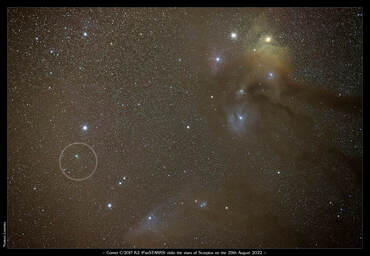
The comet was easily seen and positioned near the bright star Dschubba in the head of the constellation of Scorpius and showed a lovely clear tail. The pretty greenish colour is due to emission of diatomic carbon gases and looked just stunning among the countless stars in this part of the starry sky.
I wanted to do a wide field image to capture the full beauty of this colourful area of nebulosity around the brilliant star Antares so I used a Canon 70-200mm F2.8 lens and Canon 6D Mark 2 camera that was piggybacked on top of my tracking Meade 10inch LX200 telescope.
The first image was a wide field taken at 135mm with 25x2 minute images stacked in DSS and processed in PS CS4…. The second image was taken at 200mm with 5x4 minute images stacked in DSS and processed in PS CS4.
The Comet made its closest approach to Earth on the 14th July 2022 and from observations it seems to be still brightening. It will reach its closest point to the Sun at perihelion on December 19th 2022.
If you want to keep a live track of the comets journey through the stars please go to The Sky Live at: https://theskylive.com/where-is-c2017k2
Happy Comet Hunting, Noeleen :-)



 RSS Feed
RSS Feed
